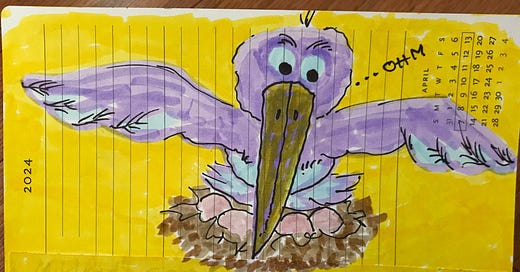A drawing is simply a line going for a walk.
-- Paul Klee
My closest beloveds will testify that I have long tended the weird fire. The first playmate I can recall as a toddler was a visible-to-me, invisible man who I spent hours with under our dining room table. He was tall, patient and slightly blue-skinned. My stuffed animals spoke to me, especially a sort-of dog that I was gifted at age two. I named him Carson Pirie Scott & Company (of all things) after a large department store in Chicago … and Carsy for short.1 We had no shortage of good things to talk about. Around age 6 or 7, I started to make the acquaintance of helium balloons that were real people to me and my mother was not allowed to tidy them away until they had fully deflated. When I was a little older and lived in the suburbs, I ferried insects I found on the sidewalk to our garden, with the well-wishing that they would always be safe from big lumbering humans and bicycles. I felt deep kinship with corn and soybeans, beavers, grasses, chickens, cows, kittens, pigs and swallows, all friends of mine who lived on my maternal grandparents’ Illinois farm … a place I ranged and rambled like a free-range chicken. I was what the Irish side of my family would call fey.
Looking back at my childhood, I realize what a precious (and maybe rare) thing it was to have parents and grandparents who were comfortable with my innate multi-dimensionality. I have always believed that everything is alive and that there is far more going on than a 3D-centric world view suggests. One of the gifts that came to my shores with Covid was the sacred art of doodling. It filled some of the little corners of my days with delight … and even more, rekindled that particular connectedness with The Everything that was very alive for me as a child.
Doodling originates from dudeldopp, which is German for simpleton or fool. It is often associated with boredom, dawdling, laziness, wasting time and irritating classroom teachers … all of that putting a disreputable spin on the word and tarnishing its reputation. How many children have been told off in school for “not paying attention” because they are scribbling in the margins of books, notebooks, and their hands? I am refreshed by the emergence of the contemporary art therapy movement which embraces the therapeutic aspects of doodling for people challenged by verbal and written expression or might be swamped by challenging feelings or are on the spectrum (which just about covers all of us at some point or another).
I have created my own parameters for doodling. All I need to begin are a pencil and paper (of any kind, not necessarily blank). I close my eyes, empty my mind and start moving the pencil around the page, keeping it in contact with the paper the whole time and flowing quickly so my thoughts don’t enter in. It is just one line with a mind of its own. I am not “drawing something”. I am giving my hand a driving license to go where it wants. It is finger jazz and a process of discovery.
I was schooled in the great art of cloud watching with my father on summer vacations. He would look up in the sky and tell me what he saw (which I could often see too) and then it would be my turn. Sometimes our cloud creatures would eat each other (which I loved) and there was always something marvelous afoot in that shifting, changing cumulus-y cloud world.
It is the same thing with a doodle. When my hand is finished, I open my eyes and start looking at the page, turning it round and round until I feel a little pulse, a tug, a presence and then a shape. And until I see somebody gazing back. There is always someone in there with a story and (for me) almost inevitably a creature, which is not surprising given my penchant for other-than-humans.
Keep reading with a 7-day free trial
Subscribe to Holy Mischief: Love, Creativity & Other Sacred Business to keep reading this post and get 7 days of free access to the full post archives.



